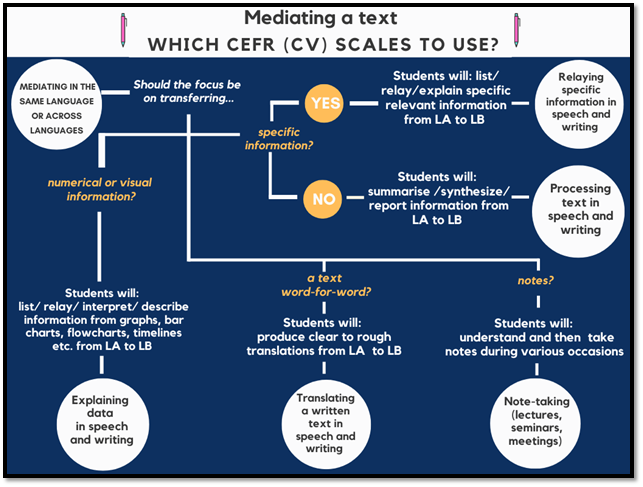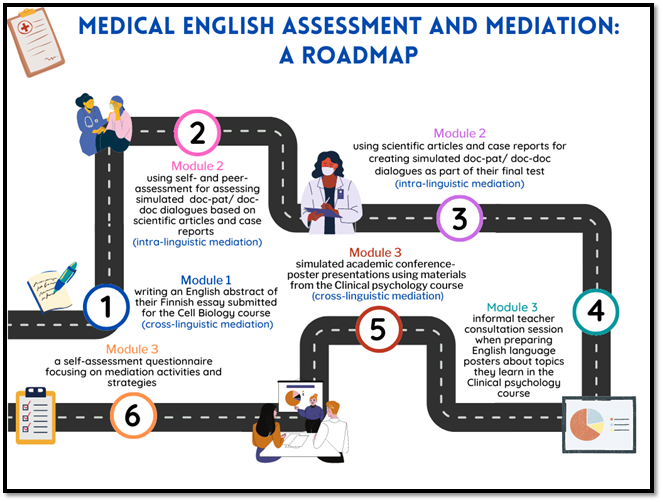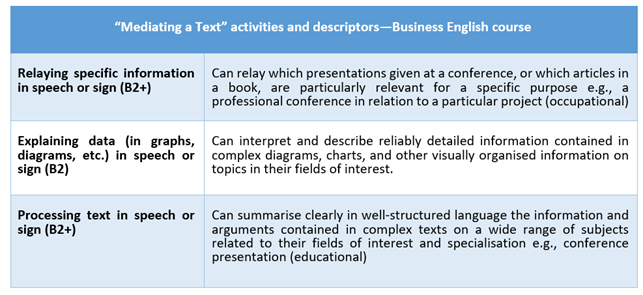Language assessment in different disciplines: uses of mediation in university English courses
Julkaistu: 10.toukokuuta 2023 | Kirjoittaneet: Magdalini Liontou ja Eva Braidwood
Introduction
Mediation was not traditionally considered as part of the palette of language skills. The word has mainly been associated with dispute resolution, both in politics and business. However, since the publication of the new Companion Volume to the Common European Framework of Reference (CEFR-CV) in 2018, the concept of mediation as a language skill has taken centre stage in discussions among foreign language teachers. We have spent considerable time in such discussions and have done extensive research owing to our own involvement with the project which aimed to support teachers in understanding this new concept, called Mediation in Teaching, Learning and Assessment (METLA) funded by the European Centre for Modern Languages of the Council of Europe (ECML). In this article, we focus on how mediation can be highlighted and supported in the foreign language classroom in Higher Education (HE). Specifically, we would like to draw attention to assessment practices of mediation skills in English for Specific/Academic Purposes (ESAP). In the first section, we discuss the overall concept of mediation as described in the updated CEFR-CV (2020). Next, we will share some of the mediation activities created for assessment purposes in our courses at the University of Oulu. Finally, we discuss the learning points each course offered in respect of developing students’ understanding and mastering of mediation skills.
Creating mediation tasks for assessment
First, let us recall the explanation of mediation as a language and communicative skill: "In mediation...the learner acts as a social agent who creates bridges and helps to construct or convey meaning sometimes within the same language (intra-linguistic mediation), sometimes from one language to another (cross-linguistic mediation)" (Companion Volume, 2020:103). There are two main points here which teachers must bear in mind when creating tasks and activities for an ESAP course: 1) the view of the learner who acts constructively, helping to facilitate understanding in the communicative situation; 2) in this process the learner may have to switch between two (or more) languages, or, within one language, the learner has to switch between styles and registers or modes of communication, such as scientific text to poster. CEFR makes the distinction between these two practices by using the categories of cross-linguistic and intra-linguistic mediation.
Cross-linguistic mediation tasks require transferring information from one language to another (from Language A to Language B) for a given communicative purpose or engaging in meaning negotiation across languages. In contrast, intra-linguistic mediation activities refer to transferring information using different variations and dialects, style and register of the same language. The CEFR-CV also describes various activities which involve mediation: mediating a text, mediating concepts, and mediating communication. In this article, we focus on the “mediating a text” activities and provide concrete examples from our courses. “Mediating a text” activities represent a task of making the information contained in a text available to people who don't have access to the original. We must clarify that ‘text’ in the CEFR-CV can refer to both a set of sentences or images in either written or spoken form. For example, when a child explains a cartoon to their grandparents because they cannot read the subtitles, or when a doctor explains the medical results to a patient in every-day language, albeit the same language, because the patient lacks the professional knowledge and vocabulary necessary to understand the diagnosis. For such “mediating a text” activities, the CEFR-CV provides specific descriptions from level A1 to C2 (p. 198 –220).

In the process of designing assessment tasks for our courses, we wished to comprehensively introduce these descriptors, and to choose the most relevant for each assessment task. The “Mediating a text” flowchart illustrates this process. When preparing the assessment task of mediation skills, whether it is focusing on the same language (intra-linguistic mediation) or shifting between various languages (cross-linguistic mediation), we start with the question, “Should the focus of the assessment activity be on transferring…?”. Next, we follow one of the available options (see flowchart “Mediating a text”). For example, if the assessment activity focuses on transferring information from a picture or a diagram, we choose the option "numerical or visual data”, and then we check the mediation activity “Explaining data in speech and writing” (CEFR-CV: 205 –207) and align the assessment activity with the appropriate proficiency level.
Finally, to make our course relevant to the students’ future work life, we created assessment mediation tasks that use authentic situations from their professional practice. To achieve this, we focused on the desired language(s) (source and target language), the genres most common in the particular fields, the purpose of mediation, and the audience of the target text.
Medical English course: an integration of formative and summative mediation assessment tasks
The Medical English course is an ESAP course offered to first-year medical students. It comprises three modules in order for students to develop various professional communication skills. The first module is integrated with the Cell Biology subject course and as part of the assessment, the students have to submit an English scientific abstract of their Finnish essay submitted to their subject course “Anatomia: Lääketieteellinen solu- ja kehitysbiologia”. In the second module, the students practice their ability to extract information from case reports and medical texts. Their task is twofold; use the text to relay this information in order to communicate effectively with patients (patient-centred interviewing), and to present cases to medical professionals using professional medical English. These activities turn into demonstration of skills during the course in the form of team presentations, and then they are tested in the end-of-course test. In these activities, the students use intra-linguistic mediation from English medical texts to English dialogues. To assess and support their development, we use informal, formative feedback before the in-class presentation, peer feedback after the in-class presentation and self-assessment. We discuss language use and register during the lessons and encourage students to contemplate the difference between various audiences (non-knowledgeable versus knowledgeable) and the purpose of the communicative situation (inform, explain, advise, etc.).
In the final module, the focus shifts to producing, presenting and assessing a specific text type in English (scientific poster). The students participate in a simulated academic conference, for which they prepare an English language poster presentation about a topic they have studied in Finnish in the Medical psychology course (Lääketieteellinen psykologia). Before their final presentation at the academic conference and the evaluation of their skills, the students have to participate in two informal group meetings, so called tutorials, with their English teachers. In the first meeting, the students present the first draft of their poster and get formative, personalised feedback from their teachers. In the second meeting, they present the final version of the poster and discuss the contents of the oral presentation with their instructor. During both sessions, the students must demonstrate actively how they have applied various mediation strategies (simplifying a text and explaining a new concept). Teacher and peer feedback helps them further develop their mediation skills before the summative assessment task, i.e., the simulated conference.
In the final task of the course, the students complete a self-assessment questionnaire. This task provides an opportunity for them to reflect on all the activities they carried out, and consequently, to identify various language skills and mediation strategies they used to complete the course successfully. Overall, students have to summarise, paraphrase, relay information, and interpret diagrams, graphs, and illustrations in the mediation assessment activities in the Medical English course. Before their summative assessment tasks, students are supported by various scaffolding tools such as formative teacher feedback, peer feedback and self-assessment lists. The diagram below presents the mediation assessment tasks chronologically and are divided based on cross-linguistic and intra-linguistic mediation activities. In a recent study exploring students' perceptions regarding the Medical English course, we reported students’ opinions about the authenticity of the mediation assessment tasks (Liontou & Braidwood, 2021). In the same article, we presented the specific CEFR-CV mediation scales we used as a guide for the academic conference assessment task.

Mediation assessment practices in the Business English course
Our second example, the Business English course, focuses on intra-linguistic mediation assessment tasks, such as transferring information from the source to the target text within the same language. Even though there are various assessment tasks in this specific course, we will describe only the ones focusing on mediation.
During the course, the students have to create and present business-related texts in English to demonstrate their ability to use an appropriate style and level of formality for business purposes. For example, they have to develop an original business idea, a process which takes almost two months, submit a document describing various steps of the concept based on the instructions, and hold a group presentation as part of their classroom assessment. Next, the students have to create a concise pitch of their original business idea and present it in a student competition. Their performance is judged by a panel of professionals along with the English teachers. With these two presentations, the students gather fifty percent of their overall grade. In this particular case, the students use intra-linguistic mediation: they have to transfer their source texts, the 12-minute business idea presentation and the submitted business idea document to a 3-minute pitch (target text). Additionally, they have to consider the audience of the target text. Previously, the audience was their classmates who had already heard versions of their business idea as they were created during the course. However, the audience of the 3-minute presentation is a mixed group: all the first-year business students and professionals invited to the pitch competition. To align this assessment task with the CEFR-CV, we considered the following mediation activities as shown in the table. Our target level of proficiency is B2-C1, so in most cases, we selected the B2+ descriptors.

Mediation and language assessment: final thoughts
Most recently, combining global and local (glocal) approaches has been recommended as a successful way for the implementation of multilingual assessment (Chalhoub-Devile, 2019). Leung, Lewkowicz, and Jenkins (2016) emphasise that English for Academic Purposes (EAP) assessment should be discipline- and institution-specific. In other words, when teachers create assessment tasks, they should acknowledge the specific communicative requirements of the discipline and the local context. The integration of subject and language courses, such as the Medical English course, offers an excellent opportunity for the implementation of mediation in language assessment tasks. Additionally, to create cross-linguistic mediation tasks that benefit the learner, the teachers must consider the source language (Finnish) and the target language (English) when creating these mediation activities. This means that we have to pay attention to both text type and the cultural aspects of communication in each language in general, and the specific features of the discipline, and make these aspects clear to students. The CEFR-CV descriptors of mediation activities can be used to create a set of assessment tasks focusing on mediation. Finally, we understand that successfully facilitating the development of students’ mediation skills is a long-term process. However, we hope the presented examples could foster a discussion regarding mediation and language assessment in the Finnish academic context.
Magdalini Liontou works as an English language teacher in the Languages and Communication unit at the University of Oulu where she teaches English for Academic Purposes (EAP) courses to undergraduate students in various disciplines. She is also a PhD researcher focusing on language assessment at the University of Jyväskylä. She is particularly interested in formative assessment, language mediation and inclusive pedagogy. She is currently a team member in the “Mediation in Teaching, Learning and Assessment” (ME.T.L.A.) project at the European Centre for Modern Languages (ECML) regarding cross-linguistic mediation in the foreign language classrooms and the “Fostering the doctor of the 21st century” (For21) Erasmus+ project.
Eva Braidwood (PhD English Lit.) has been responsible for ESP curriculum and course design for the School of Architecture and the Faculty of Medicine at the University of Oulu since 2010. Her professional and research interests include discipline specific discourse variations in academic writing, CLIL and mediation. She is an associate partner in the “Mediation in Teaching, Learning and Assessment” (ME.T.L.A.) project at the European Centre for Modern Languages (ECML) regarding cross-linguistic mediation and the University of Oulu coordinator of the “Fostering the doctor of the 21st century” (For21) Erasmus+ project. Most recently she has contributed to the EntreSTEAM Erasmus+ project on curriculum design for international team-working.
References
Chalhoub-Deville, M. B. (2019). Multilingual testing constructs: Theoretical foundations. Language Assessment Quarterly, 16(4–5), 472–480. https://doi.org/10.1080/15434303.2019.1671391
Council of Europe (2020). Common European Framework of Reference for Languages: Learning, teaching, assessment Companion volume with new descriptors. Council of Europe. https://rm.coe.int/common-european-framework-of-reference-for-languages-learning-teaching/16809ea0d4
Leung, C., Lewkowicz, J., & Jenkins, J. (2016). English for academic purposes: A need for remodeling. Englishes in Practice, 3(3), 55–73. https://doi.org/10.1515/eip-2016-0003
Liontou, M., & Braidwood, E. (2021). Mediation in practice in an ESAP course: Versions of the Medical English student conference. CEFR Journal, 4, 25–42. https://doi.org/10.37546/jaltsig.cefr4-2
